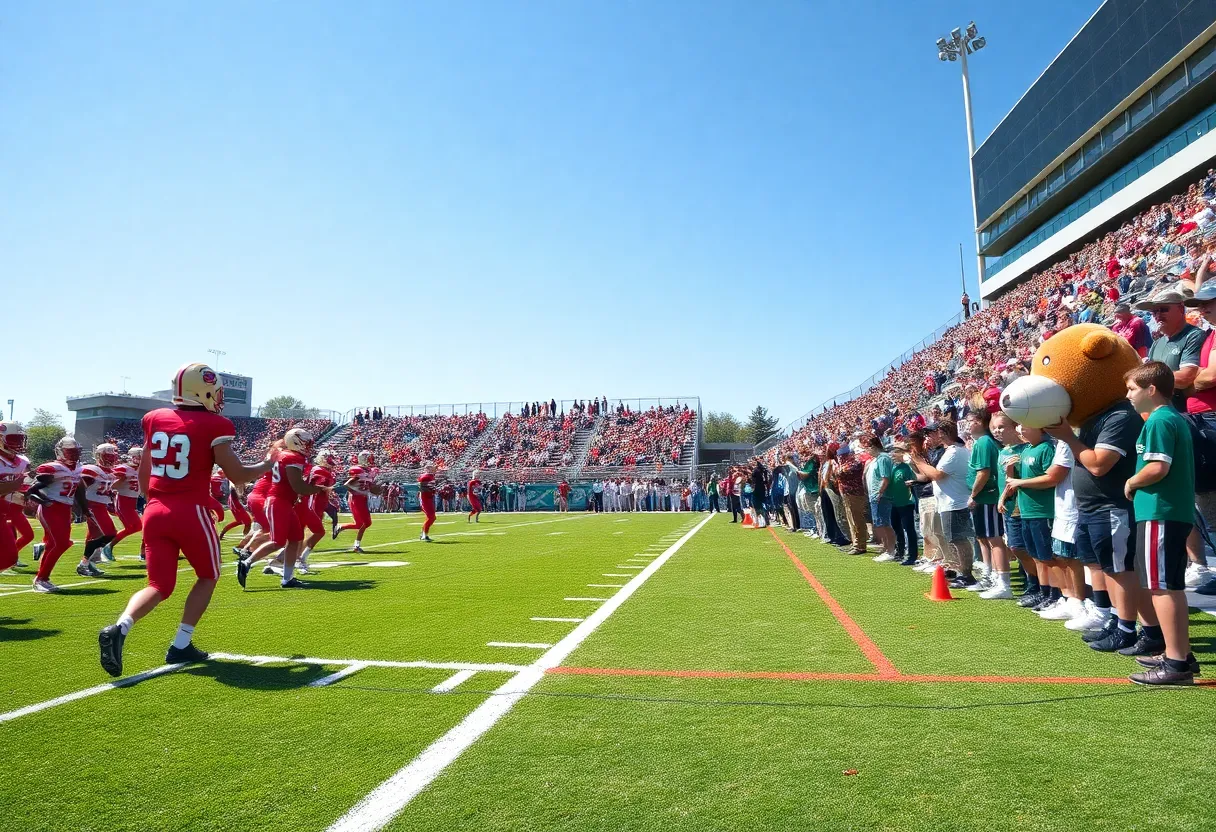Dallas, October 3, 2025
News Summary
Booster clubs play a crucial role in funding competitive high school football in the Dallas area. With 135 clubs identified, 70 focus specifically on football, providing essential resources for uniforms, equipment, and facilities. Many of these organizations are 501(c)(3) nonprofits, critical in filling budgetary gaps left by schools. The financial strength among clubs varies, with some generating significant revenue to bolster team success. This disparity highlights the influence of private funding on athletics and the importance of transparency in financial reporting.
Dallas — Booster clubs are the primary private funding source sustaining competitive high school football in the Dallas area and across Texas, providing money for equipment, facilities and programs that school budgets often cannot cover. An analysis found a total of 135 booster clubs in the Dallas area, with 70 specifically supporting football teams. Of these clubs, 95 are registered nonprofits with federal tax records, allowing them to operate as tax-exempt 501(c)(3) organizations.
What matters most
Booster clubs, parent-run nonprofits supporting athletic teams, are essential for competitive success, especially in the Dallas area. They underwrite visible investments such as stadiums, uniforms and coaching salaries and pay for less-visible but critical needs like weight-room equipment, facility maintenance and nutritional support. These clubs help fill budgetary gaps left by school districts, funding items such as weight-room equipment, facility maintenance, and nutritional programs for athletes.
Scale, variation and performance
Financial strength among booster clubs varies widely. Affluent communities can generate six- or seven-figure annual income for athletics, while programs without strong booster support frequently struggle on the field. A stark connection exists between fundraising and athletic performance, as evidenced by clubs that reported more than $200,000 in revenue supporting three of the five Dallas-area teams that reached the state championship last season. The contrast in resources helps explain why some programs consistently contend for state titles and others do not.
Financial specifics and examples
Some booster organizations combine fundraising for multiple sports under an umbrella group; others are limited to a single sport like football. The Allen Eagle Athletic Booster Association shows an example of financial intermingling, reporting $371,359 for the football-specific Touchdown Club, contributing to an overall club total of $1.7 million in 2024. These figures illustrate how a single large program within an umbrella organization can represent a substantial portion of the group’s overall revenue.
Compliance, records and reporting
Booster clubs that operate as tax-exempt entities must follow federal reporting rules. Booster clubs are required to file an annual Form 990 or a shorter Form 990-EZ for federal recognition, although clubs earning under $50,000 do not need to file but must inform the IRS they are still operating. Clubs that do not register or that operate without clear public records can be harder to track, limiting transparency about how money is raised and spent.
Coverage and data collection
An inventory of clubs in the Dallas area shows broad engagement by parents and community groups in supporting athletics. The database includes both umbrella organizations for multiple sports and groups limited to individual sports. The public is encouraged to report any booster clubs not listed in the financial database to expand resources further and improve the completeness of high school sports coverage.
Context and implications
Texas high school football is deeply embedded in the culture of the state, with significant visible investments in stadiums, uniforms, and coaching salaries. That cultural priority, combined with uneven local fundraising capacity, produces sharp disparities in resources between school programs. The push for more comprehensive booster club data aims to enrich high school sports coverage and make it easier for communities to understand how private funding shapes competitive outcomes. Players and competitive teams spotlighted by financial data demonstrate the significant impact these financial contributions on athletic performance and successes during the football season.
Key takeaways
- 135 booster clubs in the Dallas area, with 70 specifically supporting football teams.
- 95 are registered nonprofits with federal tax records, allowing them to operate as tax-exempt 501(c)(3) organizations.
- High variances in revenue can influence on-field results and program sustainability.
- Public reporting can help fill gaps in the database and improve transparency.
FAQ
Q: How many booster clubs are in the Dallas area?
A: An analysis found a total of 135 booster clubs in the Dallas area, with 70 specifically supporting football teams.
Q: How many of these clubs are registered nonprofits?
A: Of these clubs, 95 are registered nonprofits with federal tax records, allowing them to operate as tax-exempt 501(c)(3) organizations.
Q: What items do booster clubs fund?
A: These clubs help fill budgetary gaps left by school districts, funding items such as weight-room equipment, facility maintenance, and nutritional programs for athletes.
Q: Is there a link between fundraising and team success?
A: A stark connection exists between fundraising and athletic performance, as evidenced by clubs that reported more than $200,000 in revenue supporting three of the five Dallas-area teams that reached the state championship last season.
Q: Are there examples of how booster club finances are recorded?
A: The Allen Eagle Athletic Booster Association shows an example of financial intermingling, reporting $371,359 for the football-specific Touchdown Club, contributing to an overall club total of $1.7 million in 2024.
Q: What federal filings do booster clubs need to make?
A: Booster clubs are required to file an annual Form 990 or a shorter Form 990-EZ for federal recognition, although clubs earning under $50,000 do not need to file but must inform the IRS they are still operating.
Q: How does this fit into broader state culture?
A: Texas high school football is deeply embedded in the culture of the state, with significant visible investments in stadiums, uniforms, and coaching salaries.
| Feature | Key Figure or Note |
|---|---|
| Booster clubs in the Dallas area | 135 booster clubs in the Dallas area, with 70 specifically supporting football teams. |
| Registered nonprofit clubs | 95 are registered nonprofits with federal tax records, allowing them to operate as tax-exempt 501(c)(3) organizations. |
| High-revenue impact | Clubs that reported more than $200,000 in revenue supported three of the five Dallas-area teams that reached the state championship last season. |
| Example: Allen Eagle Athletic Booster Association | The Allen Eagle Athletic Booster Association shows an example of financial intermingling, reporting $371,359 for the football-specific Touchdown Club, contributing to an overall club total of $1.7 million in 2024. |
| Typical funded items | Weight-room equipment, facility maintenance, and nutritional programs for athletes. |
Deeper Dive: News & Info About This Topic
HERE Resources
Major Coaching Changes Across Dallas-Fort Worth Sports Teams
McAllen Holiday Parade Celebrates Christmas Across America
Warm Weather With Possible Storms in North Texas
Dallas Ranks Top for Meal Affordability as State Fair Opens
Oak Cliff Community Event Brings Families Together
Dallas-Area High School Football Teams Excel in Competition
Texas High School Football Week 6 Rankings Released
TLC Celebrates Legacy at State Fair of Texas Opening Weekend
FC Dallas Opens Applications for 2026 Homegrown Partner Program
Cowboys and Packers Battle to a Tie in Overtime at AT&T Stadium
Additional Resources
- Click2Houston: State High School Football Rankings Released Ahead of Week 6
- SI: Vote for Houston SE Texas High School Football Player of the Week
- Dallas News: Texas High School Football Week 6 Scores from Across the State
- MSN: Live High School Football Scores from Week 6 in Texas
- Dallas News: Dallas North Texas High School Football Booster Clubs
- Wikipedia: High School Football
- Google Search: Texas High School Football
- Google Scholar: High School Football Funding
- Encyclopedia Britannica: High School Football
- Google News: Texas High School Football

Author: STAFF HERE DALLAS WRITER
The DALLAS STAFF WRITER represents the experienced team at HEREDallas.com, your go-to source for actionable local news and information in Dallas, Dallas County, and beyond. Specializing in "news you can use," we cover essential topics like product reviews for personal and business needs, local business directories, politics, real estate trends, neighborhood insights, and state news affecting the area—with deep expertise drawn from years of dedicated reporting and strong community input, including local press releases and business updates. We deliver top reporting on high-value events such as the State Fair of Texas, Deep Ellum Arts Festival, and Dallas International Film Festival. Our coverage extends to key organizations like the Dallas Regional Chamber and United Way of Metropolitan Dallas, plus leading businesses in telecommunications, aviation, and semiconductors that power the local economy such as AT&T, Southwest Airlines, and Texas Instruments. As part of the broader HERE network, including HEREAustinTX.com, HERECollegeStation.com, HEREHouston.com, and HERESanAntonio.com, we provide comprehensive, credible insights into Texas's dynamic landscape.





